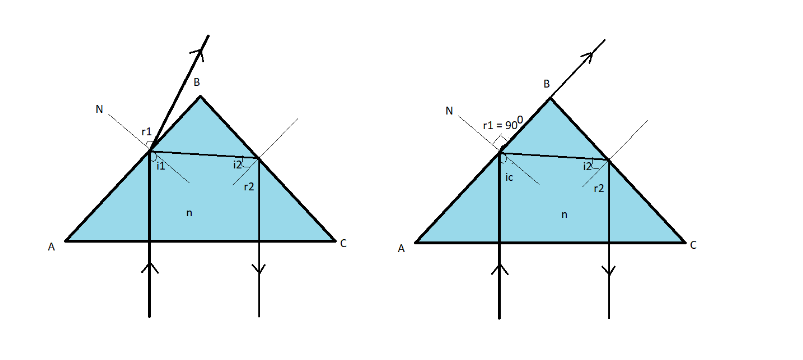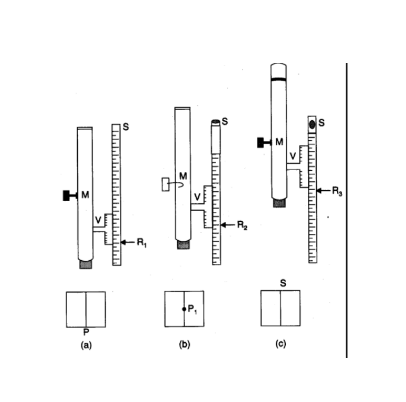Make the following table –
|
S.No |
Physical quantity |
Independent / Dependent |
Measured with |
Measuring instrument’s |
||
|
Minimum |
Maximum |
Least count |
||||
|
1 |
Angle |
Independent |
Protractor |
0⁰ |
180⁰ |
1⁰ |
|
2 |
Length |
Independent |
Travelling Microscope |
0 cm |
30 cm |
0.001cm |
-
Place a sheet of paper on a flat surface.
-
Place or mount the laser pointer such that its ray is not only horizontal to the sheet of paper, but also travels very close to its surface and leaves a streak (line) of red light on the paper. Some adjustment and practice is crucial.
-
When an uninterrupted streak of light is present, place the rectangular or square slab of glass on the paper such that the laser ray is incident on a clear side it (as shown in the figure) and exits from the opposite side. With a sharp pencil, draw four straight lines around the slab in order to register the location of the slab on the paper.
-
The ray incident on side AA of the slab making angle \(i_1\) with NN does refract and enters the slab through angle \(r_1\). See Figure. In glass, it travels to the opposite side BB and becomes incident on the other side through angle \(i_2\) and finally refracts back into air through angle \(r_2\). Mark two points on the incoming ray and two dots on the outgoing ray (with the sharpened pencil) in order to register their locations. Make sure to mark points 1 and 2 (points of incidence) as well.

-
Lift the slab and turn the laser off. On the paper, connect the marked points in order to reproduce the laser ray trace.
-
Draw two NN (Normal) lines as seen in the figure at points marked 1 and 2. Measure angles \(i_1\), \(r_2\), \(i_2\), and \(r_2\) by a protractor.
-
Use \(i_1\) and \(r_1\) and the Snell's formula to find n, the refraction index of the glass slab. Use \(i_2\) and \(r_2\) to find n again. Find the average of the two values you find for n. Use this average as your measured value for n.
- Place a flat sheet of paper on a flat surface.
- Place or mount the laser pointer such that its ray is not only horizontal to the sheet of paper, but also travels very close to its surface and leaves a streak (line) of red light on the paper. Some adjustment and practice is crucial.
- When an uninterrupted streak of light is present, place prism of glass on the paper such that the laser ray is incident on a clear side it (as shown in the figure) and exits from the opposite side. With a sharp pencil, draw four straight lines around the prism in order to register the location of the prism on the paper.
- The ray incident on side AB of the prism making angle \(i_1\) with NN does refract and exits from the prism through angle \(r_1\)( For \(r_1\) = 900, less than 900, greater than 900). See Figure. Partially reflected ray from AB side travels to the opposite side BC and becomes incident on the other side through angle \(i_2\) and finally totally internally reflect through angle \(r_2\)(If \(i_2\) is greater than Critical angle) . Mark two points on the incoming ray and two dots on the outgoing ray (with the sharpened pencil) in order to register their locations. Make sure to mark points 1 and 2 (points of incidence) as well.
-
Lift the prism and turn the laser off. On the paper, connect the marked points in order to
reproduce the laser ray trace.

- Draw two NN (Normal) lines as seen in the figure at points marked 1 and 2. Measure angles \(i_1\), \(r_2\), \(i_2\), and \(r_2\) by a protractor.
- Rotating the prism in steps of 5-100, repeat the above steps.
- Make sure to make observations when \(r_1\) = 900. Note down the corresponding \(i_1\) as the critical angle.
- Place an empty beaker with an object (coin) under a traveling microscope. Place the microscope vertically above the object and adjust the height of the instrument until the object is in sharp focus with no parallax between their image and the cross-hair, Read the vertical venire scale of the microscope and record the reading as \(d_1\).
- Pour water into a beaker.
- Repeat step 1 and record the reading as \(d_2\).
-
Put a small piece of paper (or small dried leaves) on the surface of the water. Adjust the
microscope to clearly observe this piece of paper and note down this reading as \(d_3\).

- The actual depth is \(d_3\)- \(d_1\) and apperent depth is \(d_3\)- \(d_2\).
- Reat the above steps for different levels of water in the beaker.
- Draw a graph actual depth vs apperent depth. The slope of the straight line is related to the refractive index of the water.